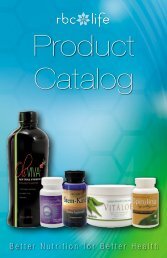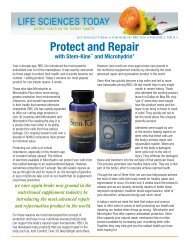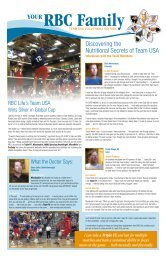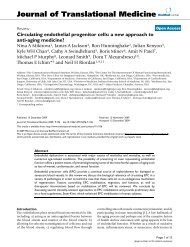Supplement Facts - RBC Life
Supplement Facts - RBC Life
Supplement Facts - RBC Life
Create successful ePaper yourself
Turn your PDF publications into a flip-book with our unique Google optimized e-Paper software.
The Healing Powers of Aloe Vera<br />
Three decades ago, <strong>RBC</strong>’s founder and CEO, Clinton Howard began hearing stories about a<br />
tropical plant called “aloe”, the juice of which had amazing benefits. It had been used by people<br />
in warm climates and by early physicians hundreds of years before Hippocrates included it in his<br />
medications. It was taken internally to improve digestion, or applied topically to soothe sunburn,<br />
cuts, scrapes, itches, insect bites, or to moisturize dry skin. It was listed among the medical<br />
supplies of explorers like Columbus, and warriors like Alexander The Great who grew his aloe on<br />
an Island near East Africa.<br />
Curious about it, he pointed to an aloe plant in a nursery<br />
and asked a sales clerk, “What is that plant?” She answered,<br />
“That is the medicine plant!” He asked a pharmacist for an<br />
aloe product, but was told there were none on the market.<br />
Now wait! This didn't add up -- Pharmaceutical companies<br />
spend billions searching for new drugs, and here is a known<br />
“medicine plant”. It was clear to this medical research<br />
pioneer that the benefits of aloe vera must be determined<br />
and made available to the public. Someone needed to<br />
conduct a scientific study of the chemistry, safety, and efficacy of aloe, have it approved, introduce it<br />
to the market, and make it available to those who need it.<br />
Clinton Howard decided to take aloe out of the realm of folk medicine. He founded Carrington<br />
Laboratories, built a research laboratory and recruited a team of five scientists who began the most<br />
comprehensive scientific study of aloe vera ever conducted. Four years and more than twenty million<br />
dollars later, they knew how to grow, process, and stabilize aloe. They demonstrated its safety and<br />
biological activity in humans and animals, and discovered its most active ingredients.<br />
They learned that the large thick aloe leaf has two useful parts:<br />
1) A yellow sap just beneath the skin that was used as a laxative, and<br />
2) the melon-like fillet that contains aloe gel used topically or cut<br />
into small portions and eaten as a health supplement. They began<br />
removing the skin by hand with a knife, and having no interest in the<br />
laxative effect, washed off all yellow sap to leave only a clean fillet.<br />
Secondly, this team of aloe researchers learned that aloe gel has<br />
many ingredients. The most active is a long chain sugar, or<br />
polysaccharide, that has incredible benefits for the immune system.<br />
They also learned that the aloe extract stimulates the reproduction of fibroblast cells by approximately<br />
300%. These are early-stage cells that form and repair connective tissue. The aloe gel was approved<br />
as a hydrogel applied to skin wounds. On the basis of its immune-system activity, the polysaccharide<br />
W H Y S U P P L E M E N T A T I O N I S V I T A L T O Y O U R G O O D H E A L T H 23







